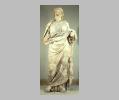
"Artemisia", frontal view
| Collection: | London, British Museum |
| Title: | "Artemisia" |
| Context: | From Halikarnassos |
| Findspot: | Excavated at Halikarnassos |
| Summary: | Standing draped female figure |
| Object Function: | Funerary |
| Material: | Marble |
| Sculpture Type: | Architectural |
| Category: | Statuary group |
| Placement: | Other sculpture in the round |
| Style: | Late Classical |
| Technique: | In-the-round |
| Original or Copy: | Original |
| Date: | ca. 350 BC |
| Dimensions: | H 2.67 m excluding base; H of head including neck 0.42 m; L of right foot 0.41 m |
| Scale: | Over life-size |
| Region: | Caria |
| Period: | Late Classical |
Subject Description:
The figure faces front, supporting her weight on her left leg. Her right leg is relaxed. The upper arms are held close to her body; both forearms are extended. In Asiatic sculpture the pose is characteristic of mourning women. She wears a chiton with buttoned sleeves, of much lighter fabric than the undergarment worn by "Mausolus". It forms numerous fine folds, especially between the breasts and on the arms. Over this she wears the himation, pulled up over her head as a veil. On her left it falls over the shoulder and down the left side, covering the upper arm almost entirely. On her right it covers the shoulder and is pulled under the forearm, across the front of the body in a twist and, finally, over the left forearm. The effect created is that of a triangular form over a pillar. The lower portion of the figure, the pillar, is much more austere than the upper torso with its multiplicity of folds. It is enlivened, however, by the long diagonal lines created by the drapery as it is pulled around the lower right leg and by the patterns created where the excess cloth is gathered over the right hip and stomach. The feet are laced in sandals, without socks.
The face is so thoroughly destroyed that it is impossible to form an impression of the facial features. However the treatment of the body, with its large, sagging stomach and breasts, suggests that the subject was portrayed as individualistically as "Mausolus". The figure certainly represents some member of Hecatomnid dynasty. Like "Mausolus" she has been disassociated from the chariot group. Her identity is not clear.
Form & Style:
The free-standing figures such as this one probably stood between the columns of the Ionic peristyle.
Date Description:
Mausolus died in 353 BC. Artemisia, who is mentioned prominently in connection with the building of the Mausoleum, died in 351 BC. The building was said to be incomplete at the time of her death. The dynasty came to an end not long after. Thus the likelihood that the project continued well into the 340s is not great. On the other hand, the Mausoleum was clearly provided for in the plan of the city, a project which should probably be attributed to Mausolus himself. The building was not necessarily begun during his lifetime, but it may have been. Since it is not known how long it took to complete the building, a date around the middle of the 4th century is the closest which can be determined.
Condition: Fragmentary
Condition Description:
The body is preserved in two main fragments (the area around the knees is restored). The head is restored from a number of fragments but joins securely at the neck. The most significant damage is to the face, which is almost entirely destroyed. Also missing: much of both lower arms, tip of left foot, back of left shoulder, small fragments of the drapery especially from the left side of the figure. The surface is weathered.
Material Description:
Pentelic marble (?Waywell)
Technique Description:
Carved from a single block of marble.
Associated Building: Halikarnassos, Maussolleion
Collection History: Excavated in 1957 by Newton; part of the large sculpture deposit north of the north peribolos wall.
Sources Used: